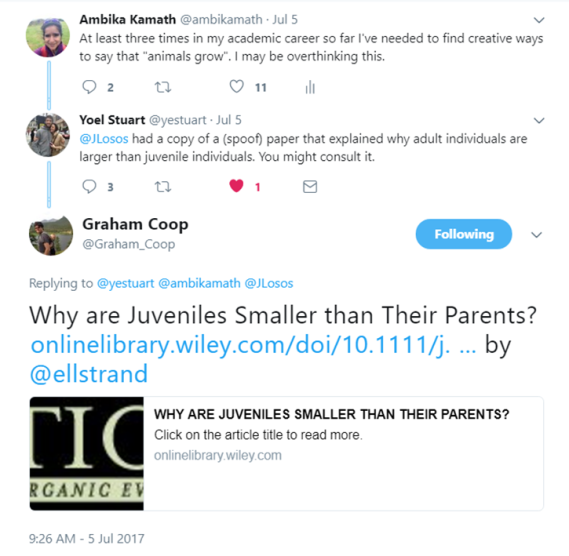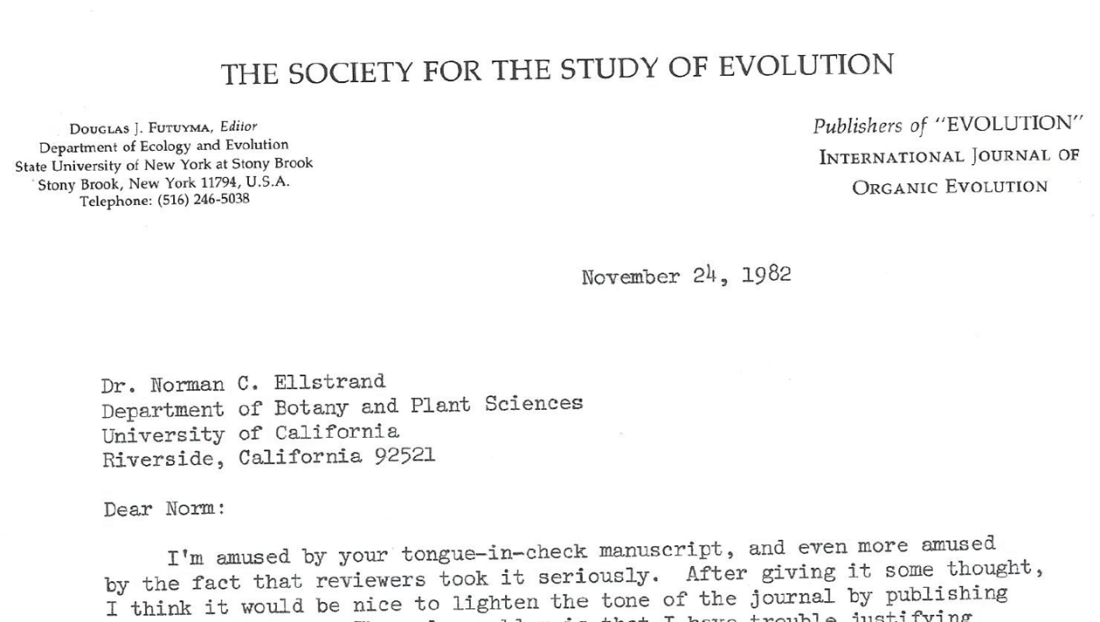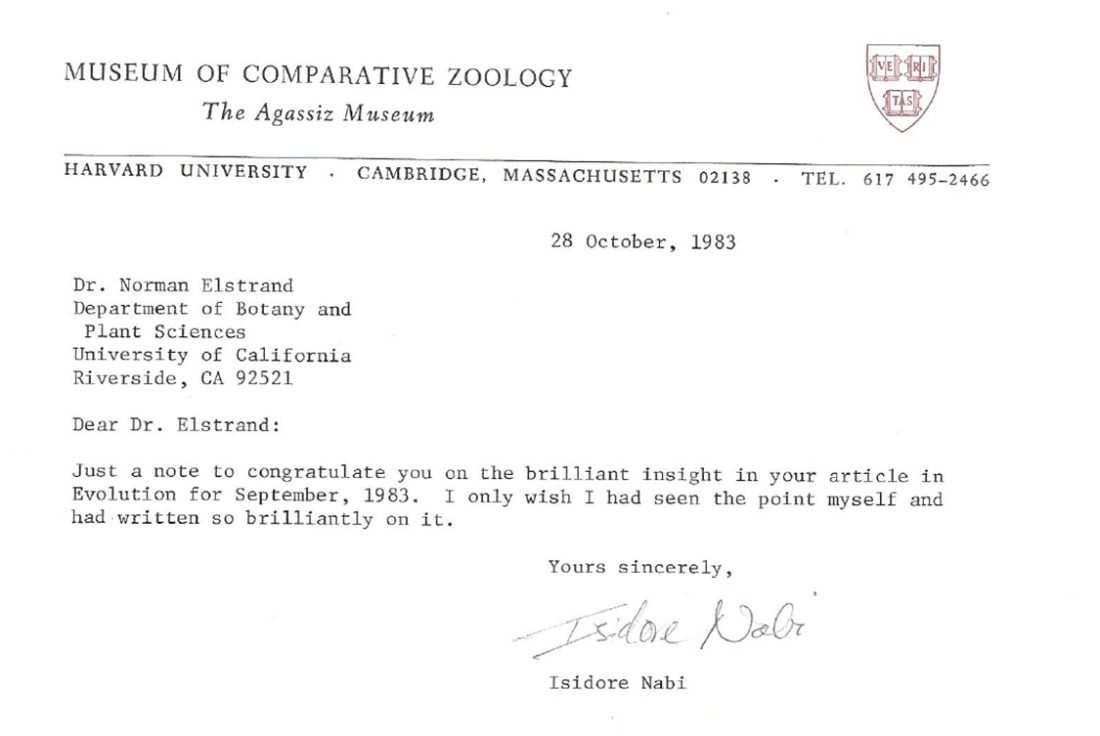In July, I was writing a paper that is, in part, about sexual selection on body size in Anolis lizards. I had found, as is common in many animals, that sexual selection favours bigger males, and was arguing that this might be tantamount to selection favouring older males because, well, animals grow.
I was agonizing over writing this section. On the one hand, I didn’t want to leave the reader to connect the dots between size and age. But on the other hand, was I really going to state the obvious? I decided that I was not only going to state the obvious, but also back it up—I found myself searching for a citation to lend the statement that animals grow a bit more gravitas, before I stopped myself and took to twitter instead.

Needless to say, I wasn’t expecting this idle, procrastinatory tweet to lead me to an actual paper! Ellstrand (1983) tackles the question of the “evolutionary significance of…the fact that juveniles at birth are usually smaller than adults,” and goes on to discuss six (six!) adaptive hypotheses for why juveniles are smaller than adults (there’s even an acronym!—“juveniles’ small size” or JSS). What makes this paper fantastic is just how plausible each of these hypotheses sounds, until you stop to really consider the question at hand. It’s delightfully deadpan, with only the last paragraph cementing a casual or careless reader’s suspicion this paper is not in fact completely serious: “Both selective and historic forces are probably responsible for JSS and why it is so widespread. Adaptive explanations can be sought for other juvenile characters as well. In particular, another juvenile character is even more widespread than JSS and deserves some thoughtful theoretical attention, the fact that juveniles always seem to be younger than their parents.”
But the story of this paper, and of that last sentence, is perhaps as whimsical as the paper itself! It all began with a reply from Ellstrand himself to our conversation on twitter.

After Ellstrand’s tantalizing response, Yoel Stuart and I decided we needed to pursue this story further. We emailed Norm with a request for the reviews and some commentary on the experience of writing and publishing this paper, and he most kindly obliged:
“The short story: I was a post-doc with Janis Antonovics in 1978-79. He and his group would often lampoon the ‘Adaptive Paradigm’; the discussion would often end with Janis saying something like ‘somebody should write a parody using a trait that is universal but has nothing to do with adaptation’. That was the inspiration.
I had some time on my hands at UCR and wrote the first draft of ‘juveniles’ in a day. After a month or so of polishing and getting feedback, I submitted it – without explanation – to American Naturalist to see what the response might be.”
The reviews from American Naturalist are fantastic. I guarantee, had I been reviewing this paper as a serious submission, I would have had the same earnest responses as reviewers 2 and 3, especially because the original submission lacked that telling last paragraph. Reviewer 2 tries valiantly, though perhaps a tad condescendingly, to rescue the paper, saying “since juveniles develop from the reproductive process of a parent, they are smaller at birth for trivial physical reasons. The real question the author is asking is not why are juveniles smaller than their parents, but rather, why is there so much variation among species in the size of the offspring at birth.” Reviewer 3 is more scathing: “While I suspect the subject and the things mentioned seem new and fresh to the author, in fact they are stale and have been worried over a great deal…I know of no papers with this title, and I can understand the author’s desire to get the question explicitly attacked. However, he does not in fact tell us anything that we don’t already carry around in our heads.” And Reviewer 1 comes so very close to figuring out the whole thing that we give you their comments in full:
“It is unclear to me that the author has chosen a significant question to study. Does the fact that juveniles are smaller than adults require an adaptive explanation, as the author indicates? How can an adult produce offspring or propagules that are in fact larger than itself? It is difficult indeed to imagine how organisms with a placental habit, such as mammals or flowering plants, could give birth to offspring with greater mass than their own. At a broader level, it is difficult to see how any organism with a nutritionally dependent juvenile could produce a juvenile with larger mass, unless the adult acts like a nutrient pump over a long time period, slowly inflating the ballooning infant.
The author suggests several adaptationist explanations, i.e. smaller infants are more easily controlled by parents, smaller juveniles eat different resources (unlikely with nutritionally dependent juveniles) that are facile. Perhaps if the question were rephrased “What are the constraints on juvenile size?”, the author’s other suggestions of dispersability, freedom from predation, etc., might provide interesting avenues for exploration. With the question as it stands, however, the author must demonstrate that in the absence of selection, juveniles larger than adults are equally possible as juveniles smaller than adults, before he invokes adaptationist answers. The author has not yet met this test, and unless he does, I am unconvinced that the question he asks is indeed meaningful.
A minor point: the lead quotation from a popular (?) record lyric [“Let’s get small”—S. Martin, 1977, actually a comedy album] does not contribute to the paper, and in fact leads me to wonder if the paper was written as a satire on the adaptationist program in general.”
SO CLOSE!
Norm continued, in his email: “The rejected [manuscript] stayed in my files for some months until it occurred to me to call Doug Futuyma [at the time, the editor of Evolution] for his advice about submitting it.”

Doug’s response, published with permission:
“Dear Norm:
I’m amused by your tongue-in-cheek manuscript, and even more amused by the fact that reviewers took it seriously. After giving it some thought, I think it would be nice to lighten the tone of the journal by publishing the essence of it. The only problem is that I have trouble justifying using the very limited (and expensive) journal space. So if you wish to go ahead with it, I will, if you are willing to figure out how to cut one or two pages of text and also delete the figure (a nice touch, but you can make your point without it). The only other issue is that there are passages in which I can understand why reviewers took it seriously—these are where you seem to be talking about whether offspring should be large or small, rather than whether they should be absolutely smaller than the parent…You may also wish to include something at the very end that is so outrageous that even the dull-witted can’t miss the point.
So send me back a shorter version, and I’ll publish it.
Best wishes,
Doug”
And then, a hand-written postscript:
“P.S. I think I’d better insist that you pay page charges”
So the paper was published, and in the following years, both Ellstrand and Futuyma received many responses to the paper, the latter getting so many complaints that he composed a marvelous form letter to send out in response:
“Dear Colleague:
I have received several inquiries about the article by Dr. Norman Ellstrand in the September 1983 issue of Evolution, entitled “Why are juveniles smaller than their parents?” Dr. Ellstrand intended the article to be a parody, and it was accepted for publication in the same spirit. The last sentence of the text of the article should make its thrust clear. Some colleagues have expressed dismay at the possibility that the article was meant to be serious. Therein lies, perhaps, both a moral to the story and an explanation for the appearance of Dr. Ellstrand’s article.
Sincerely,
Douglas J. Futuyma
Editor”
And below, a handwritten note: “Norm – I have sent this letter to several people who wrote. I hope you don’t get too much flak about the article”.
Of course, Ellstrand received regular correspondence about the paper as well. “Also, I get a letter or email once every three years or so regarding the paper,” he told us. “I have sent a scan of the one I treasure the most, from Isadore Nabi. Surprisingly, it took me about two years to learn who Nabi actually is! (Google searches not available at the time – but that’s no excuse, I guess).”
“Dear Dr. Elstrand [sic]:
Just a note to congratulate you on the brilliant insight in your article in Evolution for September, 1983. I only wish I had seen the point myself and had written so brilliantly on it.
Yours sincerely,
Isidore Nabi”
I’ll do my best to sneak in a citation of Ellstrand (1983) into my next revision of the paper that led us to uncover this exchange, and hope that someday another of my idle tweets leads to something this delightful! Many thanks to Norm Ellstrand and Doug Futuyma for giving us permission to share their words, and for scanning their correspondence.

